The Highest-End Notebooks, 2009
by Jarred Walton on October 14, 2009 3:10 AM ESTGaming Performance
Here are the complete gaming results, using 1680x1050 as the baseline for comparison with other laptops. We're including the ASUS W90Vp (Core 2 Q9000 @ 2.20GHz with 4870X2), Clevo D901C (Core 2 E6850 with 8800M GTX SLI), and a desktop system (Q6600 @ 3.30GHz with 4870X2) as a point of reference.
We include the native resolution results for each LCD as well, which means HD+ (1600x900) for the W870CU, 1080p (1920x1080) for the M980NU, and WUXGA (1920x1200) for the D900F. In some cases, we run into CPU limitations; this will be apparent when both 1680x1050 and the native resolution deliver similar results. This is most likely to occur with the M980NU SLI configuration, but it may be present elsewhere. 1680x1050 has 22.5% more pixels than 1600x900, 1920x1080 has 17.5% more pixels than 1680x1050, and 1920x1200 has 30.6% more pixels than 1680x1050. If we are purely limited by the number of pixels the GPU(s) can render, we will see similar scaling to these percentages. Most of the time, other factors such as GPU memory bandwidth, GPU geometry, and CPU performance will also influence the frame rates.
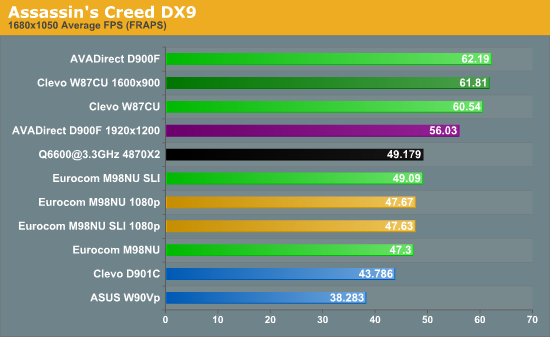
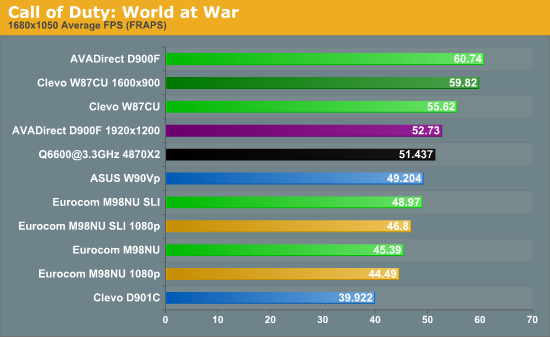

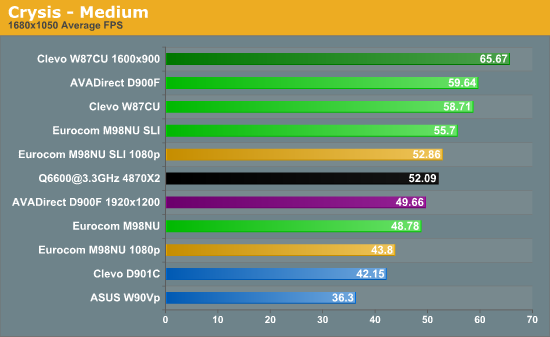
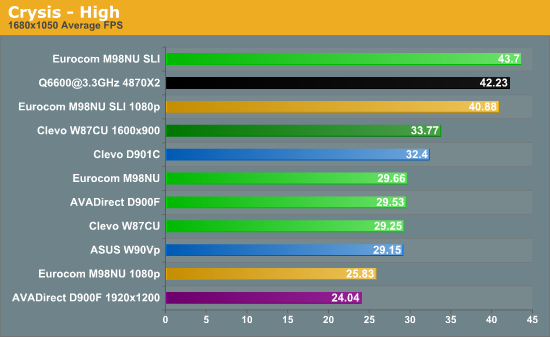
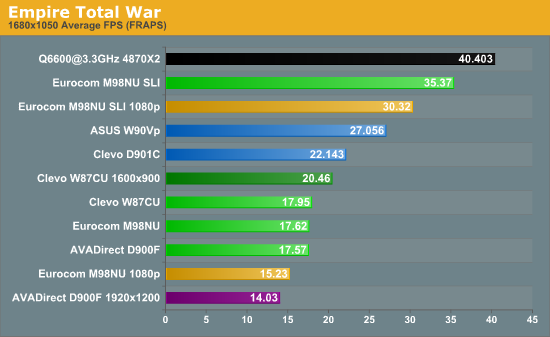
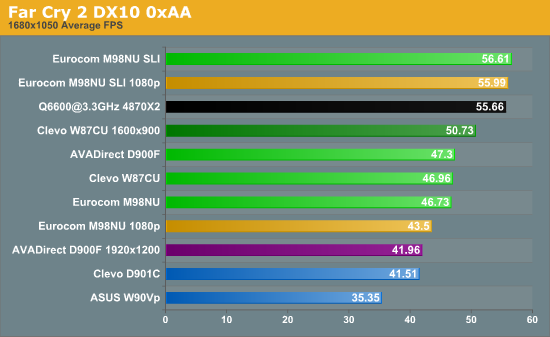
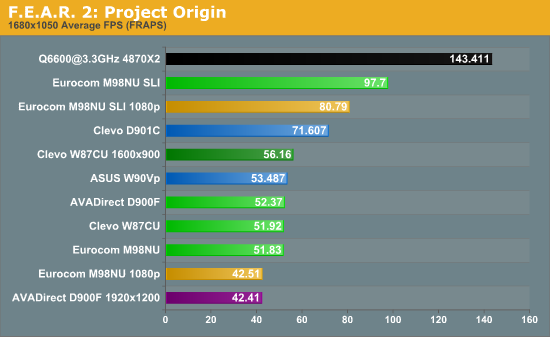
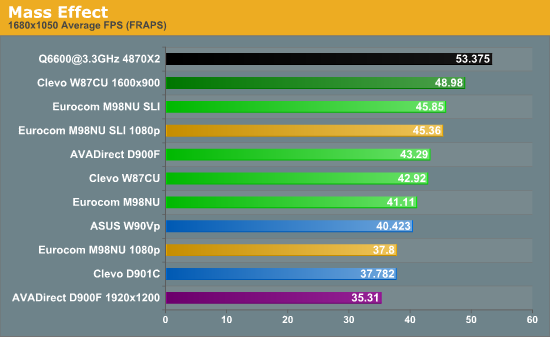
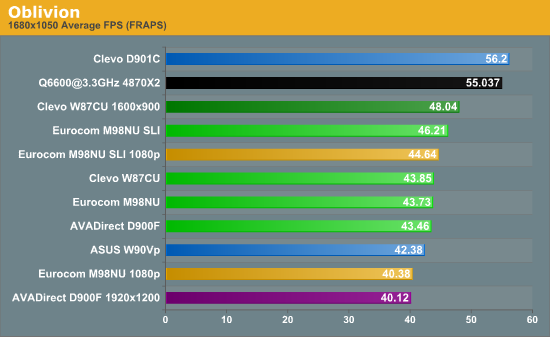

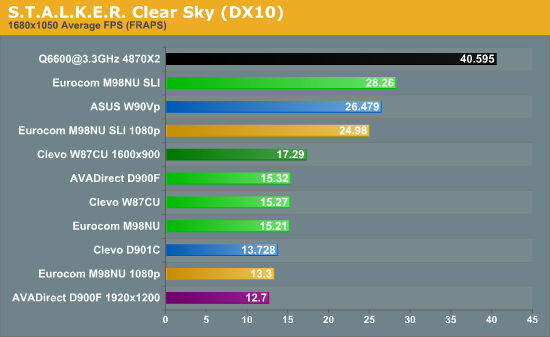
Gaming performance is about what you would expect for the most part, with the Eurocom M980NU taking top honors among the notebooks in the majority of games. However, there are definitely games where we are CPU limited with GTX 280M SLI. Assassin's Creed is the most obvious example, showing essentially no difference between SLI and single GPU mode, other than a slight increase in performance with SLI at 1680x1050. Call of Duty: World at War doesn't appear to scale very well with SLI at present -- whether this is a CPU limitation or a lack of updated SLI profiles isn't entirely clear. Crysis also appears to be running into CPU limitations, particularly at medium detail settings. Far Cry 2 with SLI could benefit from a faster CPU, and so could Mass Effect, Oblivion, and Race Driver: GRID.
On the other side of the table, we have games that scale extremely well with SLI. Dark Athena is almost completely GPU limited, along with Empire: Total War, F.E.A.R 2, and STALKER: Clear Sky. One of the interesting points is that the HD+ resolution on the W870CU is beneficial in several titles, with performance scaling almost linearly with the decrease in resolution. Any of the GPU limited titles we just mentioned should fall into this category.
On a final note, it's interesting to compare performance between the desktop system and these gaming laptops. We have to account for the fact that we are comparing ATI and NVIDIA hardware, which can definitely influence the results, but a system that now qualifies as a "midrange desktop" still comes out on top in the vast majority of these games. The only place where the desktop doesn't lead is in CPU limited titles (Assassin's Creed, Call of Duty, Crysis, and Far Cry 2), while in other titles the lead is substantial. Something the results don't show is how much easier it is to get updated drivers for the desktop. NVIDIA is doing better now with mobile reference drivers coming out quarterly, and sometimes even more frequently, but you can easily find updated desktop drivers every month for ATI cards, and just about as often for NVIDIA cards if you're willing to use beta drivers. It's possible to install unofficial beta drivers on laptops, but our experience is that performance often drops dramatically since they don't have all of the mobile hardware optimizations in place -- and don't even bother with unofficial drivers on SLI notebooks.










56 Comments
View All Comments
GeorgeH - Wednesday, October 14, 2009 - link
Wow, with all the missing words and ascerbic tone you can definitely tell I posted that way to early in the morning. ;)I cited the MBP because it has both exceptional design and widespread familiarity, and because a lot of the consumers that "convert" to Macs do so because they're used to the dramatically inferior consumer PC designs you'll find on the shelves of Best Buy and the like.
Citing something like an 8730W would have been more appropriate, but not many people even know what they are and even fewer have had the opportunity to see one in person. This isn't about me saying "Apple Rocks!" it's about me emphasizing that the design of a laptop is orders of magnitude more important than its spec sheet. With cheap LCDs and tacky glossy surfaces completely inappropriate to their price brackets, these laptops appear to be all spec sheet, no design.
gstrickler - Wednesday, October 14, 2009 - link
MBPs are available with either glossy (standard) or matte (optional) screens.Right click (2 fingers on trackpad and click) works just fine. It's not the same as having a 2 button mouse, but a mouse is often not convenient on a notebook and the 2-finger click is a lot better than having to use a separate right click button when using a trackpad.
You might try doing some research and/or using one before posting inaccurate info.
Gholam - Wednesday, October 14, 2009 - link
Touchpads suck anyway, Trackpoint > all.gstrickler - Saturday, October 17, 2009 - link
I guess that explains why just about everyone except Lenovo has abandoned the trackpoint?Or maybe, it's because very few people like them. I thought the trackpoint sounded cool when IBM introduced it in the '90s, then I tried it and found it doesn't work nearly as well or as fast as a mouse or trackpad. Yes, I've tried more recent ones. I'm clear that you like it, but you're in a very small minority and that's why the trackpoint and trackball have disappeared from almost every machine in favor of the trackpad.
The touchpad/trackpad may "suck", but they're better than anything yet devised except for the modern optical mouse. Unfortunately, a mouse isn't always convenient when using a notebook/laptop/netbook, so the touchpad/trackpad wins by virtue of "sucking less" and having fewer drawbacks than all the alternatives.
drfelip - Wednesday, October 14, 2009 - link
And laptops such as the Alienware M17x makes good use of them. Clevo should implement that in these laptops!The0ne - Wednesday, October 14, 2009 - link
Yea, the weight is less than these and it's still a burden traveling with it :) But I can't resist the WUXGA. Plus the machine is pretty speedy at C2D 2.2GHz. Full blown Vostro 17" for $850 thanks to Anand Hot Deals.As for these, it just doesn't make sense any way I look at it.
Lifted - Wednesday, October 14, 2009 - link
Not that I am interested in one of these at the moment, but it would have been interesting/useful to have at least a single $1,000 - $1,500 desktop included in the benchmarks.MamiyaOtaru - Wednesday, October 14, 2009 - link
I will never buy a glossy screen. Not on a desktop LCD, especially not on a laptop.Gholam - Wednesday, October 14, 2009 - link
These are huge, fragile, plastic boat anchors, stuffed to the gills with desktop components and tiny whiny fans struggling to keep them from melting. High end is Lenovo ThinkPad W700/W700ds, Dell Precision M6400, HP EliteBook 8730w - not this crap.JarredWalton - Wednesday, October 14, 2009 - link
I'd say some of those characteristics apply to the W870CU (it feels less durable, that's for sure), but I don't think I'd say these are "fragile" notebooks or that the fans are "tiny and whiny". The fans are about the size of what you find in high-end GPUs, and while noisy under load they're not high-pitched like some fans.I'll agree that the Precision M6400 is a much nicer build, but it also offers less performance if that's what you're after. And FWIW, Eurocom also takes the time to certify their "mobile workstations" for use with professional applications -- something that's absolutely necessary if you ever need support from one of the software companies.
But yes, they're definitely huge... just like most mobile workstations. If you're going to put two GPUs or a desktop CPU into a notebook, that's pretty much a foregone requirement.